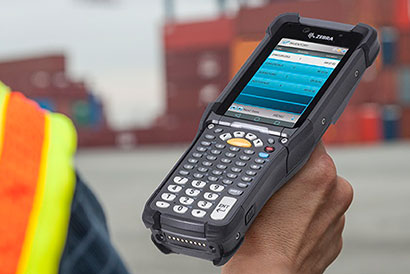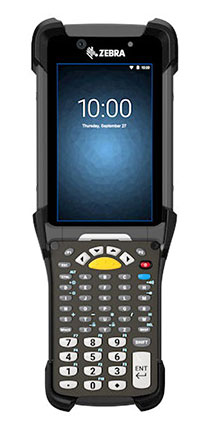|
Zebra MC9300
Popular, versatile and highly configurable pistol-grip MC9000 Series mobile computer moves to Android and gets a thorough tech update
(by Conrad H. Blickenstorfer)
With all the billions of ever more powerful smartphones in use today, there are still jobs and tasks out there much better served by traditional and seemingly quite old-fashioned mobile computers. Tasks like quickly capturing barcodes for inventory management, receiving/put-away, returns processing, cross docking, quality control, parts tracking, price audit applications and much more. And that's why in April 2019 Zebra introduced the MC9300 mobile computer, an updated version of an old workhorse design that's been around for going on 20 years and sold well over three million units, more than any other such device.

What's the secret to the longevity of a handheld computing platform that's as different from a modern smartphone as it gets? In a word, functionality. The MC9300 is a tool for the job, a multi-function tool that's as practical and versatile as a Swiss Army knife and just as indestructible.
A legacy of success and innovation
And just like a Swiss Army knife, the MC9300 is not only capable of handling all sorts of jobs, it's also available with a vast number of possible permutations of features that make it just right for this job or that, no matter what it may be. For handheld computers that scan barcodes, that means the availability of four different integrated scan engines and five different keypad layouts. And that's on top of options like cameras and special versions that can handle extreme cold or flammable environments.
Now add extreme ruggedness and durability and it should become clear why there continues to be a sizeable market for this sort of device. Smartphones in a case can be used for an amazing number of tasks todday, but there are still plenty of deployments where only a dedicated industrial-grade tool like the MC9300 will do.
In terms of evolution, the MC9000 Series goes back to 2003 when Symbol Technologies created the MC9000 as a modern, compact and lightweight flashlight-style handheld computer for barcode scanning-intensive applications. The original version was very much an industrial version of the Microsoft Pocket PC concept of the time, one available with either Windows CE or the friendlier Windows Mobile.
By 2006, Symbol had sold half a million of them, and added a number of variants such as the MC9090-G, designed for indoor use, the MC9090-K for indoor/outdoor use with support for both voice and data, the MC9090-S with a slightly smaller form factor, and the MC9097 which had Nextel Walkie-Talkie capability.
Symbol was bought out by Motorola Solutions, which then introduced the substantially updated MC9200 in June 2013, building on the overall design of the MC9000 Series, and keeping it compatible with existing peripherals and accessories, allowing for cost-effective upgrades.
In 2014, the enterprise division of Motorola Solutions, essentially the former Symbol, was acquired by Zebra Technologies. Zebra, so far, has turned out to be worthy custodian of this treasure trove of innovation and has been busy upgrading it and building on it, which isn't always easy when faced with the task of bringing a great, but aging, design up to date.
Moving forward with Android and new tech
So what has Zebra done with this latest iteration of the MC9000 platform, the MC9300? The biggest challenge was to bring a design that was originally created for a miniature version of Windows operated by keypad and stylus over to the Android operating platform that now dominates smartphones and small tablets.
 Android, created to compete with the iPhone in the smartphone arena, is designed for capacitive multi-touch. That meant a bigger screen for the MC9300 (4.3 vs 3.7 inches in the MC9200), though the MC9300 can still be used with a stylus. Android, created to compete with the iPhone in the smartphone arena, is designed for capacitive multi-touch. That meant a bigger screen for the MC9300 (4.3 vs 3.7 inches in the MC9200), though the MC9300 can still be used with a stylus.
On the software and functionality side, Zebra has considerable experience with Android. There's Zebra's "Mobility DNA," an integrated suite of business, management, productivity and development tools that turns Android into an enterprise-ready OS.
To address Android version anxiety, Zebra guarantees a minimum of two major Android OS upgrades. And since a lot of MC9300 users will move from existing Windows Embedded Handheld/CE 7 devices, Zebra aims to make the transition from legacy Windows OS to Android as painless as possible via preloaded terminal emulation and a wealth of migration tools and services.
On the technology side, the MC9300 benefits from completely reworked underpinnings. Processor, RAM, mass storage, wired and wireless communications, sensors, cameras, and the available barcode scanner lineup are all current tech and optimized for use with Android. This includes a quick 2.2GHz octa-core Snapdragon 660 processor, support of high-capacity SDXC microSD cards, fast dual-band 802.11ac WiFi, Bluetooth 5.0, NFC, and a much more powerful battery. The MC9300 also doubles as a walkie-talkie with Voiceover-IP support and pre-licensed PTT Express software.
Like its predecessors, the MC9300 offers multiple short, mid or long range scanning options. Available integrated scanners also include the SE4750 DP that quickly and reliably reads barcodes that are etched or imprinted directly into the surface of plastics and metals. A pistol-style grip reduces fatigue in extended bar code scanning applications. And the scanner window is protected via Corning Gorilla Glass.
As rugged as can be
The MC9300 is designed to hold up even in very harsh and demanding work conditions. An operating temperature range of -4 to 122 degree Fahrenheit allows use in just about any environment. A special "cold storage" version operates in temperatures as low as -22F. The device passed a stringent "tumble" test (2,000 tosses from a meter) and can handle six-foot drops to concrete no matter what the temperature is (and eight foot drops in room temperature). Sealing has been bumped up from the MC9200's IP64 to IP65/67.
Migrating into the future
Overall, with the new MC9300, Zebra offers the very large number of MC9000 Series users a modern and largely future-proof upgrade/replacement option with backwards accessory compatibility, extensive customization, and easy migration to Android. -- Conrad Blickenstorfer, April 2019
|



